 |
Great Western Railway and Somerset & Dorset Joint Railway Signalling at Wells |
 |
||||||||
|
||||||||||
Although Wells is the smallest city in England, at one time it boasted the terminal stations of no less than three separate railways. This page describes the signalling arrangements which existed at each of those three stations.
 The
first railway to arrive in Wells was the Somerset Central Railway
(SCR), which in 1859 opened an extension of its existing branch-line from
Highbridge to Glastonbury. The SCR approached Wells from the south-west and
their terminus was situated immediately to the west of Priory Road. The next
railway arrived from the east in 1862, when the East Somerset Railway
(ESR) opened a line from Witham via Shepton Mallet to a separate
terminus east of Priory Road, just across the road from the SCR. Finally from
the north-west in 1870 came the Cheddar Valley branch of the Bristol &
Exeter Railway (B&ER) from Yatton to a terminus at Tucker Street. The
ESR and B&ER lines became part of the Great
Western Railway (GWR) in 1874 and 1876 respectively. The SCR became
part of the Somerset & Dorset Railway, which later became the
Somerset & Dorset Joint Railway (S&DJR).
The
first railway to arrive in Wells was the Somerset Central Railway
(SCR), which in 1859 opened an extension of its existing branch-line from
Highbridge to Glastonbury. The SCR approached Wells from the south-west and
their terminus was situated immediately to the west of Priory Road. The next
railway arrived from the east in 1862, when the East Somerset Railway
(ESR) opened a line from Witham via Shepton Mallet to a separate
terminus east of Priory Road, just across the road from the SCR. Finally from
the north-west in 1870 came the Cheddar Valley branch of the Bristol &
Exeter Railway (B&ER) from Yatton to a terminus at Tucker Street. The
ESR and B&ER lines became part of the Great
Western Railway (GWR) in 1874 and 1876 respectively. The SCR became
part of the Somerset & Dorset Railway, which later became the
Somerset & Dorset Joint Railway (S&DJR).
All three lines were built originally to the 7' 0¼" 'broad' gauge, but by 1862 the SCR was mixed-gauge and then 4' 8½" standard gauge only by 1870. The ESR was converted to standard gauge in 1874 and the B&ER line circa-1876. The three separate termini were all within a few hundred yards of each other and eventually they were linked together, although the precise historical details are unclear. It is believed that the the ESR may have extended across Priory Road (then known simply as the "Turnpike Road") soon after it was opened, while the B&ER line probably was connected to the SCR in 1870 - at least part of the trackwork became mixed gauge in due course in common with the SCR. However these connections could not be used for passenger traffic because the Board of Trade objected to the working of passenger trains across the SCR goods yard. It was only in 1878 that through running of passenger trains commenced between the East Somerset and Cheddar Valley lines through the S&DJR station - but it was not until 1934 that GWR passenger trains actually stopped at Priory Road station!
Each of the three stations had its own signal-box. It is believed that in early days these were called WELLS 'A' (at Priory Road), WELLS 'B' (at East Somerset) and WELLS 'C' (at Tucker Street), but eventually the 'B' box became known as "WELLS EAST SOMERSET" and the 'C' box became "WELLS TUCKER STREET". In 1896 the GWR ordered new nameplates (in its standard cast-iron style) for all three boxes using the new names, the one for the 'A' box reading "WELLS SOMERSET & DORSET BOX"; unusually that nameplate was positioned above the windows on the gable end nearest the station, rather than on the front wall, presumably so as to face GWR trains passing between the two GWR stations. Despite the name now displayed on the former 'A' box, the various surviving S&DJR signal diagrams still bore the legend "WELLS A" and usually the S&DJR called it simply "WELLS". (In a few S&DJR documents the location is mentioned as "Wells Junction", being a junction between GWR and S&DJR lines, but care should be taken not to confuse such references with the early Wells Branch Junction signal-box which once existed near Glastonbury.) For most of its life the 'A' box appears never to have displayed a nameboard on its front wall facing the S&DJR branch, but by early British Railways (BR) days the ex-GWR nameplate had been removed and replaced by a "WELLS PRIORY ROAD" nameboard on the front wall in a more conventional location below the windows (there is one indistinct photograph which suggests that both nameboards co-existed for a short period). Also in BR days the signal-box at Tucker Street was renamed "WELLS STATION" and fitted with a replacement pressed aluminium nameplate smaller than the GWR version.
There was an interesting mixture of signals used by the two railway companies. The GWR used their standard pattern of signals with lower-quadrant (LQ) wooden arms on wooden posts, but some were renewed in British Railways days by tubular steel posts with metal arms. GWR ground-signals originally might have been the 'miniature semaphore' type, but eventually they had the usual round white discs. The S&DJR originally also used wooden-post signals with wooden LQ arms, but some posts were replaced subsequently by lattice posts (as used by the London & South Western Railway) and others by posts made from old rails (in the S&DJR style). The lattice posts had white-painted boards fitted to the front, a feature believed to be designed to improve signal sighting. During alterations in 1949 some of the S&DJR LQ arms were replaced by metal upper-quadrant versions. S&DJR ground signals originally were the Stevens 'flap' type, but later the Southern Railway standard Westinghouse 'half-disc' type appeared. It is likely that originally all the signal-boxes had working distant signals (including 'splitting' distants for trains approaching from the east towards the junction at Priory Road), but by about 1910 all the distants had been 'fixed' at caution.
It is probable that the S&DJR line was worked originally by Block Telegraph between Wells 'A' and Wells Branch Junction. However after the abolition of Wells Branch Junction in 1878 the new single-line section WELLS 'A' - GLASTONBURY had 'Train Staff and Ticket' (TS&T) working until about 1895, when Electric Train Tablet(ETT) working was introduced (using Tyer's No 1 instruments). The short EAST SOMERSET - WELLS 'A' and WELLS 'A' - TUCKER STREET sections were worked under GWR regulations by a special 'no staff' system, which used ordinary GWR block instruments and bells without any form of physical train staff. (The block instrument and bell in East Somerset box for working to the 'A' box can be seen in this picture.) Sometime between 1920 and 1930 WELLS 'A' box was provided with 'switching out' facilities, so that it could be shut whenever the Glastonbury line was not in use and EAST SOMERSET - TUCKER STREET worked as a single block section under the same 'no staff' system.
 On the Cheddar Valley line TS&T working was in use by 1886, at which time
the first block section west of Wells was TUCKER STREET -
CHEDDAR, but in 1896 a block-post was opened at Wookey and the new
section TUCKER STREET -
WOOKEY was worked by Electric Train Staff (ETS). After Wookey
signal-box closed in 1954 the section again became TUCKER STREET -
CHEDDAR, but this time worked by Electric Key Token (EKT). On the
East Somerset line the first block section east of Wells was EAST SOMERSET -
CRANMORE, on which TS&T working was in use by 1880. A block-post
was opened at Shepton Mallet in 1894 and it is believed that the new
EAST SOMERSET - SHEPTON MALLET section
was worked by TS&T originally, but converted to ETS in 1894 and then to EKT by 1948
(possibly in 1942). The picture (click for larger image) shows the ETS
instrument for that section in East Somerset box in 1935; all the staffs were
fitted with Annett's keys for unlocking the GF at Dulcote Quarry.
On the Cheddar Valley line TS&T working was in use by 1886, at which time
the first block section west of Wells was TUCKER STREET -
CHEDDAR, but in 1896 a block-post was opened at Wookey and the new
section TUCKER STREET -
WOOKEY was worked by Electric Train Staff (ETS). After Wookey
signal-box closed in 1954 the section again became TUCKER STREET -
CHEDDAR, but this time worked by Electric Key Token (EKT). On the
East Somerset line the first block section east of Wells was EAST SOMERSET -
CRANMORE, on which TS&T working was in use by 1880. A block-post
was opened at Shepton Mallet in 1894 and it is believed that the new
EAST SOMERSET - SHEPTON MALLET section
was worked by TS&T originally, but converted to ETS in 1894 and then to EKT by 1948
(possibly in 1942). The picture (click for larger image) shows the ETS
instrument for that section in East Somerset box in 1935; all the staffs were
fitted with Annett's keys for unlocking the GF at Dulcote Quarry.
WELLS 'A' signal-box stood at the junction of the S&DJR and GWR lines, on the Down side of the S&DJR branch from Glastonbury, and controlled the the S&DJR station at Priory Road. The history of this box is obscure, but it was very similar to a design used by the Bristol & Exeter Railway and it is believed that it was built at B&ER expense about 1876 in conjunction with the introduction of passenger services across the link line between the East Somerset and Cheddar Valley lines. (This may explain why the box came to be fitted with a GWR nameplate in later years.) The signal-box was equipped originally with a 32-lever interlocking-frame, which was positioned at the front of the box facing the Glastonbury branch (sadly the type of lever-frame is unknown, but one may speculate that, given the apparent B&ER involvement, it might have been of a Saxby & Farmer design). In 1949 the original lever-frame was replaced by a 28-lever Westinghouse frame located at the rear of the box, as part of which work the Up Home signal (3) was abolished and replaced by electrical controls on the levers of the relevant Down Starting signals in the East Somerset box.
| Wells 'A' Signal Box | ||||||
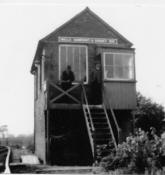 |
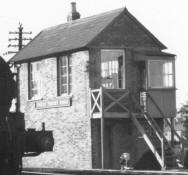 |
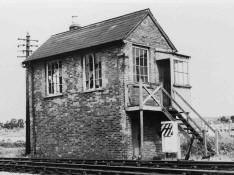 |
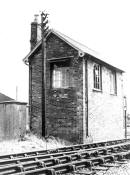 |
|||
| Circa-1948 | Circa-1950 | After 1955 closure | After 1955 closure | |||
| Click any picture for larger image | ||||||
On 25-March-1906 the S&D Down Distant signal was renewed and relocated 300 yards further away towards Glastonbury (S&DJR Signal Instruction (SI) No 219). At one time there were both Outer and Inner 'splitting' Up Distants for both the Glastonbury and Tucker Street routes, but both Up Distants for the Glastonbury route were abolished on 6-September-1910 (SI 219); it was probably at the same time that both Up Distants for the Tucker Street route were 'fixed' in the 'on' position. About 1920-22 there was a re-arrangement of the various connections into the goods yard, which included the replacement of several 'point discs' by independent shunt signals worked from the box (the latter on 29-October-1922 reported in SI 271). On 27-January-1925 (SI 278) the S&D Down Home (30), together with the lower distant arm for East Somerset, was moved 50 yards further away from the signal-box. At an unknown date between 1922 and 1930 the arrangements for working the 'from Tucker Street' Home (27) were altered so that the signal-box could 'switch out' whenever the Glastonbury branch was closed and the signals could be left 'off' in both directions for trains on the GWR route.
| Wells 'A' Signal Diagrams | ||||
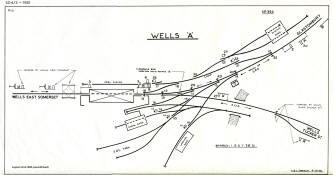 |
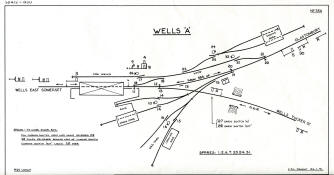 |
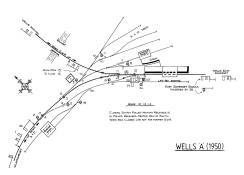 |
||
| Old lever-frame circa-1920 | Old lever-frame circa-1930 | New lever-frame circa-1950 | ||
| Click any diagram for larger image | ||||
At East Somerset station a signal-box was opened by 1877 with a frame of 28 levers; it was situated on the south side of the line east of, and a short distance away from, the level-crossing over Priory Road. It was closed on 3-July-1912 and replaced by a GWR Type 27C timber box, which was built on the same side of the line immediately adjacent to the level-crossing. The new signal-box had a 21-lever frame, reputedly with 'stud' interlocking. This signal-box used to have an external staircase at the east end with an internal porch, but when a new turntable was built close to the signal-box in 1948 the staircase was moved to the west end (and an external porch fitted) in order to prevent a signalman falling accidentally into the turntable pit when coming down the steps.
| Wells East Somerset Signal Box | ||||
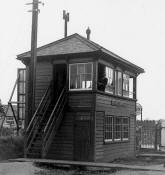 |
 |
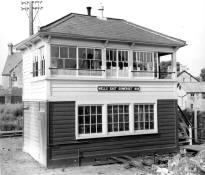 |
||
| Exterior in 1935 | Interior in 1935 | Exterior in BR period | ||
| Click any picture for larger image | ||||
In 1942 a government war-time food storage depot was constructed on the Down side of the line east of the engine-shed area, with sidings accessed by a connection in the single-line facing to Down trains. This connection was controlled by a new 2-lever Gate Lane ground-frame (GF), located on the Up side of the line, which was unlocked by the key-token for the Wells East Somerset - Shepton Mallet section (it is possible that it was the opening of this depot and GF was prompted the change from ETS to EKT working on that section).
In 1949 the Up Home signal for Wells 'A' box (located opposite East Somerset's Up Home (3)) was abolished and superseded by electrical controls on the levers of East Somerset's Down Starting signals (20 and 13). In connection with the closure of Wells 'A' box on 2-December-1955 (see below), East Somerset box took over the working of some signals and points at the Tucker Street end of Priory Road station which gave access to the former S&DJR goods yard. The existing 'stud' lever-frame was replaced by a new 27-lever frame with BR(WR) 5-bar Vertical Tappet interlocking, but a numbered diagram for the new layout is not yet available here.
At Tucker Street station a signal-box was opened in 1876 which contained 13 levers and stood on the Down platform between the road overbridge and the station buildings. Sadly there are no known photographs of this building, but probably it was similar to the other S&F Type 4 boxes built on the Cheddar Valley line by the signalling contractors Saxby & Farmer. In 1901 the GWR built a replacement box on the opposite (Up) platform, which was opened on 15th September that year. This was a brick-built GWR Type 7B box, which measured 25'x12'x7'6" to the operating floor and contained a 27-lever frame with GWR Double-Twist locking. In 1936 the signalling was altered in connection with the provision of Sheldon's Siding, which had a facing connection at the Priory Road end of the Down loop.
 The Glastonbury branch was closed completely on 29-October-1951 along with
Priory Road passenger station. However a short length of the former branch was
retained at Priory Road in order to provide access to the goods yard, which was
served now by trains from the ex-GWR line until freight traffic ceased on
13-July-1964. The Wells 'A' signal-box remained in use initially to control the
revised layout, but eventually it was closed on 2-December-1955; control of the
former junction and remaining signals passed to East Somerset box, where a
replacement 27-lever frame was installed to work the new layout. A new 2-lever
BR(WR)-pattern GF
(click picture on right for larger image) was
installed adjacent to the former Wells 'A' box to work the connection between the
goods yard and the remaining stub of the former Glastonbury branch. The block
section became WELLS EAST SOMERSET - WELLS STATION
and was worked by Electric Key Token (EKT), the token being used to unlock the new
GF
at Priory Road.
The Glastonbury branch was closed completely on 29-October-1951 along with
Priory Road passenger station. However a short length of the former branch was
retained at Priory Road in order to provide access to the goods yard, which was
served now by trains from the ex-GWR line until freight traffic ceased on
13-July-1964. The Wells 'A' signal-box remained in use initially to control the
revised layout, but eventually it was closed on 2-December-1955; control of the
former junction and remaining signals passed to East Somerset box, where a
replacement 27-lever frame was installed to work the new layout. A new 2-lever
BR(WR)-pattern GF
(click picture on right for larger image) was
installed adjacent to the former Wells 'A' box to work the connection between the
goods yard and the remaining stub of the former Glastonbury branch. The block
section became WELLS EAST SOMERSET - WELLS STATION
and was worked by Electric Key Token (EKT), the token being used to unlock the new
GF
at Priory Road.
All passenger services ceased between Yatton and Witham on 9-September-1963. On 28th October that year Wells Station box was reduced to GF status (as also were the boxes at Cheddar, Axbridge and Sandford & Banwell) and EKT working was replaced by a single 'One Engine in Steam' (OES) section between Wells and Congresbury. (The 'staff' for this new section was apparently a re-labelled key-token from one of the former EKT sections, with a key to unlock intermediate GFs at Wookey and Draycott.) EKT working was abolished also between Wells Station and East Somerset boxes and replaced by 'Yard' working; it is unclear what happened to the Priory Road GF, but it is believed that it remained in use until the ex-S&DJR goods yard and its associated connections were taken out of use on 12-October-1964. Wells Station box was closed finally on 9-April-1964, but it would appear that the OES section and Yard working remained unchanged until October that year (see below).
On 1-October-1964 the line between Yatton and Cheddar (exclusive) was closed completely, after which the OES section became East Somerset to Cheddar. Then on 3-May-1965 both East Somerset and Shepton Mallet boxes were abolished (along with their EKT sections) and the line through Wells became part of an OES section from Cranmore to Cheddar; this section was equipped with a round, red wooden train staff, which was fitted with an Annett's key to operate the various intermediate GFs. At East Somerset all the signals were abolished except for the Distants, which were retained as markers. The level-crossing gates were disconnected from the box, chained and padlocked across the line, and thereafter were operated by the train-crew. The points formerly worked from the box were converted to padlocked hand-points, but the East Somerset and Gate Lane GFs remained in use. Subsequently Gate Lane GF and the connection into the food depot were taken out of use on 1-November-1966. On 19-May-1968 OES working on the Cranmore - Cheddar section was abolished and thereafter the line was worked simply as a siding. On 29-April-1969 the line from Cheddar through Wells to Dulcote Sidings (exclusive) was closed completely, marking the end of the Cheddar Valley line and all rail traffic at Wells.
Postscript...
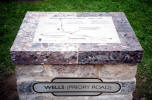 On 6-March-2002 three commemorative plaques were unveiled at Wells to mark
the sites of its three former railway stations. Each plaque has a stainless
steel information plate fixed on a slab of Draycott marble, mounted on a pillar
made from stone from the dismantled Burcott Road overbridge formerly adjacent to Tucker
Street station. The name of each station is displayed on the front of its
pillar in the style of a BR 'totem' sign. The accompanying picture (click for
larger image) was taken by the author at the unveiling ceremony at the site of
the former Priory Road station.
On 6-March-2002 three commemorative plaques were unveiled at Wells to mark
the sites of its three former railway stations. Each plaque has a stainless
steel information plate fixed on a slab of Draycott marble, mounted on a pillar
made from stone from the dismantled Burcott Road overbridge formerly adjacent to Tucker
Street station. The name of each station is displayed on the front of its
pillar in the style of a BR 'totem' sign. The accompanying picture (click for
larger image) was taken by the author at the unveiling ceremony at the site of
the former Priory Road station.
© CJL Osment 2001-19
Closed
Wells 'A' and replacement GF photographs courtesy
Wells Railway Fraternity, Wells East Somerset
1935 and ETS instrument photographs by Ian Scrimgeour courtesy
Signalling Record Society,
Wells 'A' 1950 and East Somerset and Tucker Street signal diagrams courtesy
Signalling Record Society.
All other diagrams and photographs from WCRA collection.